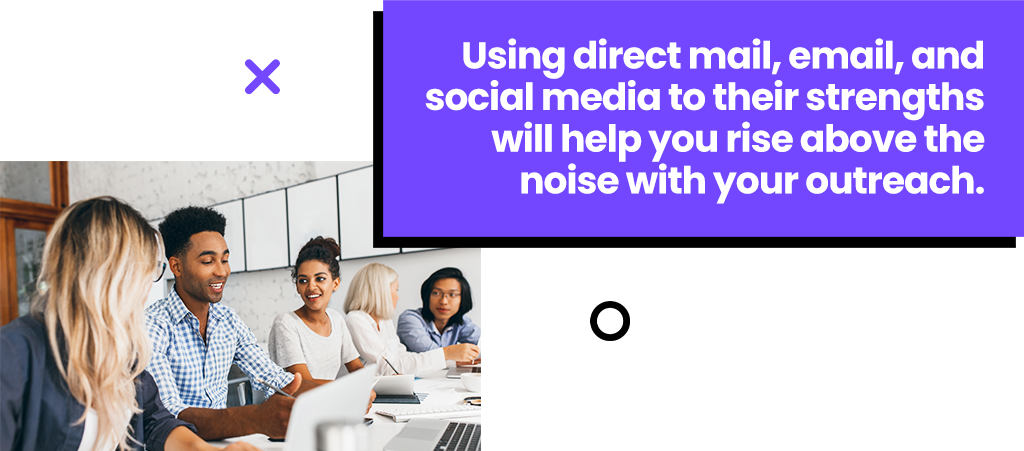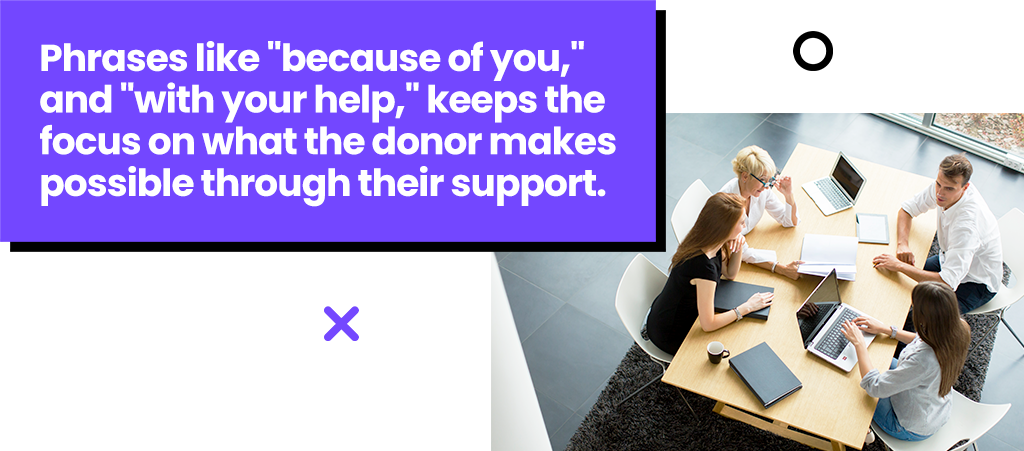Integrated messaging, cross-channel communications, multi-medium marketing. You’ve heard all these before. But let’s ditch the complicated jargon. After all, effectively going surround sound and rising above the noise is a difficult task as is!
We’re going to break it down as simply as we can. So, here’s what you need to know to effectively go surround sound with your fundraising outreach.
Tell the story in bite-sized pieces.
Every story has a beginning, middle, and end. So why are you cramming all three parts into every touch point?
Going surround sound makes it easy to extend your story throughout the entire campaign cycle. Start by introducing the problem you’re trying to solve in an email blast. Encourage your audience to follow you on social media to stay up to date with your organization’s activities.
Then, you can keep building the story with your social posts. Flesh out the middle of your story by explaining what your organization is doing to make a difference. Give progress updates as you get closer to your goals and be sure to let your supporters know what they can do to help.
Finally, wrap your story up in an appeal letter towards the end of your campaign. Let your donors know what they’ve helped you accomplish so far, and then call on them to help fulfill your mission!
READ MORE: How you can tell a more donor-centric story.

Don’t just copy and paste.
Remember, the point of going surround sound is to make an impression and inspire action by reaching donors in the right place, with the right message, at the right time.
While we are big fans of repurposing the content you already have, you need to be creative about it. Give your donors some credit. They can tell if the email they just received looks, feels, and sounds identical to the appeal letter they opened a week ago.
And remember to consider this next point when you’re thinking of ways to tell your story in different ways during a campaign.
READ MORE: It’s time to rethink your nonprofit’s appeal letter.

Every medium has strengths.
As a fundraiser, you have a lot of options in your toolbox. So far, we’ve touched on using email, direct mail, and social media in your outreach. Taking the time to consider how to use each of these platforms to their strength will help you create more engaging messages and avoid the copy and paste issue we covered earlier.
Use emails to tell your story and show the impact your donors have on your goals in ways your appeal letters simply can’t. An email blast can be a great way to share a short video that tells your story in a more visual way.
As we mentioned, social media is a great way to share your story in small, digestible parts. And if you encourage your followers to share your posts, they can help you tap into new audiences with goals and motives similar to their own. So emphasize easily shareable content for your social channels!
And remember, each social platform has its own strengths too! For example, Instagram is great for sharing pictures of your nonprofit’s mission in action. While Twitter can be used to start conversations about important issues related to your cause.
But you shouldn’t underestimate direct mail! After all, you can do much more with print than send an appeal letter once or twice a year.
For example, few things will get a new donor as excited as receiving a thoughtful welcome kit in the mail.
And don’t forget to use direct mail to follow up after important fundraising emails! Remember, donors are three times more likely to give online in response to a direct mail appeal than an email, according to MobileCause.
READ MORE: How to secure support with your social media appeal.
Effective branding helps connect the dots.
It needs to be clear that your communications are part of the same initiative when you go surround sound. Donors should be able to connect the dots on their own. And the best way to make sure your supporters know the email they just received builds on prior communications is to use a cohesive brand for your campaign.
We’re not reinventing the wheel here. We’re just talking about going the extra mile to connect the dots on your end, so the donor doesn’t have to!
Make sure images, logos, tone, and fonts are consistent throughout all your messages in a campaign when you go surround sound. And consider coming up with a unique name for any special initiatives, like your monthly giving program, to set those messages apart from the rest of your organization’s outreach.
READ MORE: Enhancing the experience with effective event branding.

Remind donors of their impact.
It’s important to be donor centric in your outreach. And there’s a lot that goes into that! But for now, let’s focus on reminding the donor what they’re doing to further your mission.
You should consistently remind your donors about what they’ve helped you accomplish!
That point is important, because too many nonprofits focus on what the organization is doing rather than what the donor makes possible.
Use phrases like “because of you,” “with your help,” and “your support has helped us” in messages and mediums throughout the campaign. Not just in your appeal letters and thank you’s!
This will help you keep the donor at the front and center of all the stories you tell. They need to understand that your work would not be possible without their help!

Don’t doubt your data.
As you know, every nonprofit is different. They face different challenges, are talking to different audiences, have different resources available, and require different solutions.
So, while we can offer a few generic tips to help you go surround sound, we can’t spell out the perfect strategy for your organization in a simple blog post!
And that’s why it’s so important to let data drive your decision making.
Is your audience highly engaged on social media? We don’t know. But your data does! So, listen to it.
If your organization struggles to stand out on social media, it shouldn’t be the focus of your campaign. And if supporters rarely open your emails, you may need to use more direct mail pieces to reach them.
Every nonprofit is unique in an immeasurable number of ways. However, we find most have more data and know more about their audiences than they think!
So, before you build a campaign that goes surround sound, listen to your data and let it guide your decisions. Then, track your results, and use what you learn to keep improving your approach.









